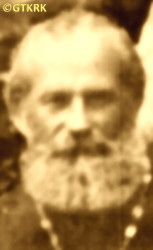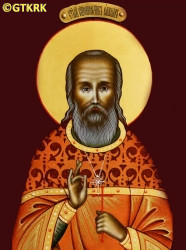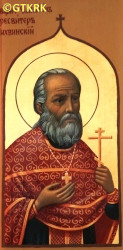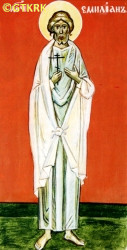Roman Catholic
St Sigismund parish
05-507 Słomczyn
85 Wiślana Str.
Konstancin deanery
Warsaw archdiocese, Poland
full list:
displayClick to display full list

searchClick to search full list by categories
wyświetlKliknij by wyświetlić pełną listę po polsku

szukajKliknij by przeszukać listę wg kategorii po polsku

Martyrology of the clergy — Poland
XX century (1914 – 1989)
personal data
religious status
saint
surname
PANASIEWICZ
forename(s)
Emilian

canonisation date
07.05.2003

Council of Bishops of the Russian Orthodox Churchmore on
en.wikipedia.org
[access: 2020.09.24]
function
presbiter (i.e. iereus)
creed
Eastern Orthodox Church ORmore on
en.wikipedia.org
[access: 2014.09.21]
diocese / province
Warsaw‐Vistula OR eparchymore on
pl.wikipedia.org
[access: 2023.07.16]
nationality
Ukrainian
date and place
of death
03.12.1937

Tikhvintoday: Tikhvin city reg., Leningrad oblast, Russia
more on
en.wikipedia.org
[access: 2020.09.24]
details of death
At the beginning of the World War I interned by Austrian authorities on 05.08.1914 in Busko (a few days later, the First Cadre Company, commanded by Joseph Piłsudski, entered Busko on the march towards Kielce).
Held in internment camps in Germany and Austro–Hungary, prob. in Vienna prison and IL Drosendorf internment camp, among others (according to other sources, as detained for half a year in the camp in Düsseldorf, half a year in the prison at Karlštejn Castle, for a year in a military prison in Vienna and half a year in an internment camp in Ellmau).
Released in 07.1917.
In 08.1917 went to Kiev — his family prob. after Russian defeat by German and Austro–Hungarian troops at battle of Gorlice in 05.1915 escaped with most of Orthodox to Russia (mass exodus).
From there moved to Kharkiv.
In 1919 evacuated with university to Sevastopol (prob. after successful attack by White's General Denikin forces).
After Denikin's defeat and capture in 1921 of Sevastopol by the Bolsheviks moved to Vyazhma.
There arrested by the Russians on 27.11.1929.
Sentenced by Russian criminal OGPU court to 3 years in slave labour camps (later Gulag).
Moved to ITL SLON special camp on Solovetsky Islands.
In 1933 released.
Returned to Vyazhma but the church had been shut down by the Russians.
Thus moved to Tikhvin n. Sankt Petersburg.
There arrested again on 29.09.1937.
Held in Tikhvin prisoni.
Accused of „counter–revolutionary activities”.
On 25.11.1937 tried by Russian genocidal kangaroo court known as «NKVD Troika», together with a number of clerics from Tikhvin.
Did not plead guilty.
Sentenced to death and murdered.
cause of death
mass murder
perpetrators
Russians
sites and events
11.08.1937 Russian genocideClick to display the description, Great Purge 1937Click to display the description, ITL SLONClick to display the description, ITL BelbaltLagClick to display the description, GulagClick to display the description, IL DrosendorfClick to display the description
date and place
of birth
14.08.1876Birth certification on:
photos.szukajwarchiwach.gov.pl
[access: 2025.10.15]

Obszatoday: Obsza gm., Biłgoraj pov., Lublin voiv., Poland
more on
en.wikipedia.org
[access: 2020.09.24]
alt. dates and places
of birth
02.08.1876
(Julian calendar)
parents
PANASIEWICZ John
🞲 ?, ? — 🕆 ?, ?

BOGUTIN Aleksandra
🞲 ?, ? — 🕆 ?, ?
baptism
22.08.1876Birth certification on:
photos.szukajwarchiwach.gov.pl
[access: 2025.10.15]

Obszatoday: Obsza gm., Biłgoraj pov., Lublin voiv., Poland
more on
en.wikipedia.org
[access: 2020.09.24]
Dormition of the Blessed Virgin Mary OR church
presbyter (holy orders)
ordination
22.10.1906

positions held
1934 – 1937
parish priest — Tikhvintoday: Tikhvin city reg., Leningrad oblast, Russia
more on
en.wikipedia.org
[access: 2020.09.24] ⋄ All the Saints OR church
1933 – 1934
parish priest — Zvanytoday: Velikii Dvor, Velikii Dvor, Boksitogorsky reg., Leningrad oblast, Russia ⋄ OR church
1921 – 1929
parish priest — Vyazmatoday: Vyazma city reg., Smolensk oblast, Russia
more on
en.wikipedia.org
[access: 2023.07.16] ⋄ The entry of the Lord into Jerusalem and St Florus and St Laurus the Martyrs OR church
1919 – 1921
second presbiter (Eng. priest, i.e. iereus) — Sevastopoltoday: Sevastopol city rai., Crimea Aut. Rep. obl., Ukraine
more on
en.wikipedia.org
[access: 2020.07.31] ⋄ St Nicholas OR church (Brotherhood Cemetery)
1918 – 1920
student — Kharkivtoday: Kharkiv urban hrom., Kharkiv rai., Kharkiv obl., Ukraine
more on
en.wikipedia.org
[access: 2022.08.05] ⋄ law, Kharkiv University — in 1919 evacuated to Sevastopol
c. 1913 – 1914
parish priest — Buskotoday: Busko‐Zdrój, Busko‐Zdrój gm., Busko‐Zdrój pov., Holy Cross voiv., Poland
more on
en.wikipedia.org
[access: 2022.05.29] ⋄ OR church
from 17.06.1913
parish priest — Płońsktoday: Płońsk urban gm., Płońsk pov., Masovia voiv., Poland
more on
en.wikipedia.org
[access: 2021.12.18] ⋄ St Mary Magdalene OR parish
from 22.02.1913
parish priest — Miechówtoday: Miechów gm., Miechów pov., Lesser Poland voiv., Poland
more on
en.wikipedia.org
[access: 2021.06.07] ⋄ Intercession of the Blessed Virgin Mary OR parish
01.11.1906 – c. 1913
priest — Łęczycatoday: Łęczyca urban gm., Łęczyca pov., Łódź voiv., Poland
more on
en.wikipedia.org
[access: 2021.12.18] ⋄ St Nicholas the Wonderworker OR church ⋄ Warsaw 3rd distr.Orthodox deanery name
today: Masovia voiv., Poland
more on
en.wikipedia.org
[access: 2021.10.09] OR deanery
priest — Sapotskintoday: Sapotskin ssov., Grodno dist., Grodno reg., Belarus
more on
en.wikipedia.org
[access: 2020.11.27] ⋄ Transfiguration of the Lord OR parish — parish priest's assistant
22.10.1906
presbiter (Eng. priest, i.e. iereus) — Russian Orthodox Church ⋄ Warsaw‐Vilnius OR eparchy — priesthood cheirotonia, i.e. ordination, on 21.10.1906 preceded by deacon cheirotonia
from 01.07.1904
psalmist — Słupcatoday: Słupca gm., Słupca pov., Greater Poland voiv., Poland
more on
en.wikipedia.org
[access: 2021.12.18] ⋄ St Nicholas the Wonderworker OR church
01.09.1902 – 01.05.1904
psalmist — Łęczycatoday: Łęczyca urban gm., Łęczyca pov., Łódź voiv., Poland
more on
en.wikipedia.org
[access: 2021.12.18] ⋄ St Nicholas the Wonderworker OR church ⋄ Warsaw 3rd distr.Orthodox deanery name
today: Masovia voiv., Poland
more on
en.wikipedia.org
[access: 2021.10.09] OR deanery — also: prefect of elementary schools
01.08.1901 – 1902
psalmist — Sahryńtoday: Werbkowice gm., Hrubieszów pov., Lublin voiv., Poland
more on
en.wikipedia.org
[access: 2021.12.18] ⋄ St Ciril and St Methodius OR church ⋄ Hrubieszów 3rd districtOrthodox parish name
today: Hrubieszów pov., Lublin voiv., Poland
more on
en.wikipedia.org
[access: 2021.08.20] OR deanery
01.12.1900 – 1901
psalmist — Łukówtoday: Łuków urban gm., Łuków pov., Lublin voiv., Poland
more on
en.wikipedia.org
[access: 2020.09.24] ⋄ St Nicholas the Wonderworker OR church
c. 1900
psalmist — Szkopytoday: Repki gm., Sokołów Podlaski pov., Masovia voiv., Poland
more on
en.wikipedia.org
[access: 2023.07.16] ⋄ Holy Trinity OR church
till 1900
student — Chełmtoday: Chełm city pov., Lublin voiv., Poland
more on
en.wikipedia.org
[access: 2021.08.20] ⋄ philosophy and theology, Orthodox Theological Seminary
married — two daughters
others related
in death
KULHAWIECClick to display biography Simeon, STEPANIUKClick to display biography George, HUTKOClick to display biography Basil (Bp Ambrose), NIKATOWClick to display biography Alex, OSTROUMOWClick to display biography Michael (Bp Seraphim), SAWICKIClick to display biography Yaroslav, SIENKIEWICZClick to display biography Alex, GAGALUKClick to display biography Anthony (Abp Onuphrius), STROCIUKClick to display biography Leontius, BLUMOWICZClick to display biography John, SZACHMUĆClick to display biography Roman (Fr Seraphim), MIEDWIEDIUKClick to display biography Vladimir, SMOLENIECClick to display biography Alexander (Abp Arsenius), MARCENKOClick to display biography Alexander (Abp Anthony), BORZAKOWSKIClick to display biography Alexander (Abp Agapit), DIERNOWClick to display biography Anatol (Abp Abramius)
sites and events
descriptions
11.08.1937 Russian genocide: On 11.08.1937 Russian leader Stalin decided and NKVD head, Nicholas Jeżow, signed a «Polish operation» executive order no 00485. 139,835 Poles living in Russia were thus sentenced summarily to death. According to the records of the „Memorial” International Association for Historical, Educational, Charitable and Defense of Human Rights (Rus. Международное историко‐просветительское, правозащитное и благотворительное общество „Мемориал”), specialising with historical research and promoting knowledge about the victims of Russian repressions — 111,091 were murdered. 28,744 were sentenced to deportation to concentration camps in Gulag. Altogether however more than 100,000 Poles were deported, mainly to Kazakhstan, Siberia, Kharkov and Dniepropetrovsk. According to some historians, the number of victims should be multiplied by at least two, because not only the named persons were murdered, but entire Polish families (the mere suspicion of Polish nationality was sufficient). Taking into account the fact that the given number does not include the genocide in eastern Russia (Siberia), the number of victims may be as high as 500,000 Poles. (more on: en.wikipedia.orgClick to attempt to display webpage
[access: 2016.03.14])
Great Purge 1937: „Great Terror” (also «Great Purge», also called „Yezhovshchyna” after the name of the then head of the NKVD) — a Russian state action of political terror, planned and directed against millions of innocent victims — national minorities, wealthier peasants (kulaks), people considered opponents political, army officers, the greatest intensity of which took place from 09.1936 to 08.1938. It reached its peak starting in the summer of 1937, when Art. 58‐14 of the Penal Code about „counter‐revolutionary sabotage” was passed , which became the basis for the „legalization” of murders, and on 02.07.1937 when the highest authorities of Russia, under the leadership of Joseph Stalin, issued a decree on the initiation of action against the kulaks. Next a number of executive orders of the NKVD followed, including No. 00439 of 25.07.1937, starting the liquidation of 25,000‐42,000 Germans living in Russia (mainly the so‐called Volga Germans); No. 00447 of 30.07.1937, beginning the liquidation of „anti‐Russian elements”, and No. 00485[2] of 11.08.1937, ordering the murder of 139,835 people of Polish nationality (the latter was the largest operation of this type — encompassed 12.5% of all those murdered during the «Great Purge», while Poles constituted 0.4% of the population). In the summer of 1937 Polish Catholic priests held in Solovetsky Islands, Anzer Island and ITL BelbaltLag were locked in prison cells (some in Sankt Petersburg). Next in a few kangaroo, murderous Russian trials (on 09.10.1937, 25.11.1937, among others) run by so‐called «NKVD Troika» all were sentenced to death. They were subsequently executed by a single shot to the back of the head. The murders took place either in Sankt Petersburg prison or directly in places of mass murder, e.g. Sandarmokh or Levashov Wilderness, where their bodies were dumped into the ditches. Other priests were arrested in the places they still ministered in and next murdered in local NKVD headquarters (e.g. in Minsk in Belarus), after equally genocidal trials run by aforementioned «NKVD Troika» kangaroo courts.
ITL SLON: Russian Rus. Исправи́тельно‐Трудово́й Ла́герь (Eng. Corrective Labor Camp) ITL Rus. Солове́цкий ла́герь осо́бого назначе́ния Ла́герь (Eng. Solovetsky Special Purpose Camp) SLON — concentration and slave forced labor camp (within what was to become Gulag complex) — headquartered in Solovetsky Islands in Arkhangelsk Oblast. Founded on 13.10.1923 in a famous Orthodox monastery. In the 1920s, one of the first and largest concentration camps in Russia. The place of slave labor of prisoners — at forest felling, sawmills, peat extraction, fishing, loading work on the Murmansk Railway Main Line, in road construction, production of food and consumer goods, at the beginning of the construction of the White Sea ‐ Baltic canal, etc. The concept of the later system of Russian Gulag concentration camps prob. had its origins in the Solovetsky Islands camp — from there the idea spread to the camps in the area covered by the construction of the White Sea ‐ Baltic canal, i.e. ITL BelBaltLag, and from there further, to the entire territory of the Russian state. From the network of camps on the Solovetsky Islands — also called the Solovetsky Islands archipelago — prob. also comes the concept of the „Gulag Archipelago” created by Alexander Solzhenitsyn. It is estimated that tens to hundreds of thousands of prisoners passed through the Solovetsky Islands concentration camps. At its peak, c. 72,000 prisoners were held there: e.g. 14,810 (12.1927); 12,909 (03.1928); 65,000 (1929); 53,123 (01.01.1930); 63,000 (01.06.1930); 71,800 (01.01.1931); 15,130 (1932); 19,287 (1933) — c. 43,000 of whom were murdered, including the years 1937‐1938 when c. 9,500 prisoners were transported from the camp and murdered in several places of mass executions, including Sandarmokh, Krasny Bor and Lodeynoye Polye. Among them were many Catholic and Orthodox priests. After the National Socialist Party came to power in Germany in 1933, a German delegation visited the ITL SLON camp, to „inspect” Russian solutions and adopt them later in German concentration camps. It operated until 04.12.1933, with a break from 16.11.1931 to 01.01.1932, when it was part of and later became a subcamp of the ITL BelBaltLag camp. It operated as such until 1939 (from 1936 as a prison). (more on: old.memo.ruClick to attempt to display webpage
[access: 2024.04.08])
ITL BelbaltLag: Russian Rus. Исправи́тельно‐Трудово́й Ла́герь (Eng. Corrective Labor Camp) ITL Rus. Беломоро‐Балтийский (Eng. White Sea ‐ Baltic Sea) — concentration and slave forced labor camp (within the Gulag complex) — headquartered in Medvezhjegorsk on Lake Onega, and in 1933‐1934 also in the town of Nadvoytsy (both then in the Karelo‐Finnish Republic, today the Karelian Republic). Founded on 16.11.1931, on the basis of the former ITL SLON camp (i.a. on the Solovetsky islands on the White Sea). Prisoners slaved at the construction of a canal between the White Sea and the Baltic Sea (opened on 30.06.1933). Later, as part of the newly created White Sea ‐ Baltic Sea Combine, managed by the criminal GPU (later the genocidal NKVD), slaved on forest clearing, in sawmills, on the construction of factories for wooden products and paper production, on the construction of hydroelectric power plants (Tulomskaya and Onda), a nickel factory and alcohol distilleries, construction of ports, and laying of railway lines., etc. One of heads of the camp was a Jew, Naftali Frenkel, regarded as the originator of the Gulag system. At its peak c. 110,000 prisoners were held there: e.g. 107,900 (12.1932); 70,373 (01.01.1934); 66,418 (01.01.1935); 90,290 (01.01.1936); 58,965 (01.01.1937); 79,232 (01.10.1938); 86,567 (01.01.1939); 71,269 (01.01.1941); 67,928 (15.06.1941). In 1938 there were 3,946 women among them. According to official data, 12,300 perished during the construction of the canal itself — according to unofficial data, from 50,000 to 300,000. The camp operated until 18.09.1941, and the entire project — in economic terms — turned out to be a total failure. (more on: ru.wikipedia.orgClick to attempt to display webpage
[access: 2022.09.02], en.wikipedia.orgClick to attempt to display webpage
[access: 2014.05.09])
Gulag: The acronym Gulag comes from the Rus. Главное управление исправительно‐трудовых лагерей и колоний (Eng. Main Board of Correctional Labor Camps). The network of Russian concentration camps for slave labor was formally established by the decision of the highest Russian authorities on 27.06.1929. Control was taken over by the OGPU, the predecessor of the genocidal NKVD (from 1934) and the MGB (from 1946). Individual gulags (camps) were often established in remote, sparsely populated areas, where industrial or transport facilities important for the Russian state were built. They were modeled on the first „great construction of communism”, the White Sea‐Baltic Canal (1931‐1932), and Naftali Frenkel, of Jewish origin, is considered the creator of the system of using forced slave labor within the Gulag. He went down in history as the author of the principle „We have to squeeze everything out of the prisoner in the first three months — then nothing is there for us”. He was to be the creator, according to Alexander Solzhenitsyn, of the so‐called „Boiler system”, i.e. the dependence of food rations on working out a certain percentage of the norm. The term ZEK — prisoner — i.e. Rus. заключенный‐каналоармец (Eng. canal soldier) — was coined in the ITL BelBaltLag managed by him, and was adopted to mean a prisoner in Russian slave labor camps. Up to 12 mln prisoners were held in Gulag camps at one time, i.e. c. 5% of Russia's population. In his book „The Gulag Archipelago”, Solzhenitsyn estimated that c. 60 mln people were killed in the Gulag until 1956. Formally dissolved on 20.01.1960. (more on: en.wikipedia.orgClick to attempt to display webpage
[access: 2024.04.08])
IL Drosendorf: Germ. „Internierungslager” (Eng. „Internment camp”) founded in Lower Austria by the Austro‐Hungarian Empire at the beginning of World War I in 08.1914 in a specially adapted building of a grain granary. Later, camp barracks were added, one of which became the camp hospital. During their construction — and also as help for local farmers — internees were used. The camp, planned for c. 1,700 people, initially housed about 650 prisoners, mainly Russians and Serbs. After the start of the Austro‐Italian war on 23.05.1915, most of the camp was evacuated to make room for the „Reichsitalians”, i.e. Italian Germans. At that time, after the expansion, up to 2,000 prisoners of war could stay in the camp, mainly Italians, but also other nations. The camp ceased operation after the end of the war, in 11.1918. (more on: de.wikipedia.orgClick to attempt to display webpage
[access: 2023.07.16])
sources
personal:
drevo-info.ruClick to attempt to display webpage
[access: 2020.09.24], pravoslavnoe-duhovenstvo.ruClick to attempt to display webpage
[access: 2020.09.24], photos.szukajwarchiwach.gov.plClick to attempt to display webpage
[access: 2025.10.15], kuz3.pstbi.ruClick to attempt to display webpage
[access: 2020.09.24]
bibliographical:
„Hierachy, clergy and employees of the Orthodox Church in the 19th‐21st centuries within the borders of the Second Polish Republic and post–war Poland”, Fr Gregory Sosna, M. Antonine Troc-Sosna, Warsaw–Bielsk Podlaski 2017
original images:
pravoslavnoe-duhovenstvo.ruClick to attempt to display webpage
[access: 2020.09.24], levashovo-hram.ruClick to attempt to display webpage
[access: 2020.09.24], alexandrtrofimov.ruClick to attempt to display webpage
[access: 2020.09.24], alexandrtrofimov.ruClick to attempt to display webpage
[access: 2020.09.24]
LETTER to CUSTODIAN/ADMINISTRATOR
If you have an Email client on your communicator/computer — such as Mozilla Thunderbird, Windows Mail or Microsoft Outlook, described at WikipediaPatrz:
en.wikipedia.org, among others — try the link below, please:
LETTER to CUSTODIAN/ADMINISTRATORClick and try to call your own Email client
If however you do not run such a client or the above link is not active please send an email to the Custodian/Administrator using your account — in your customary email/correspondence engine — at the following address:

giving the following as the subject:
MARTYROLOGY: PANASIEWICZ Emilian
To return to the biography press below:
 Click to return to biography
Click to return to biography











